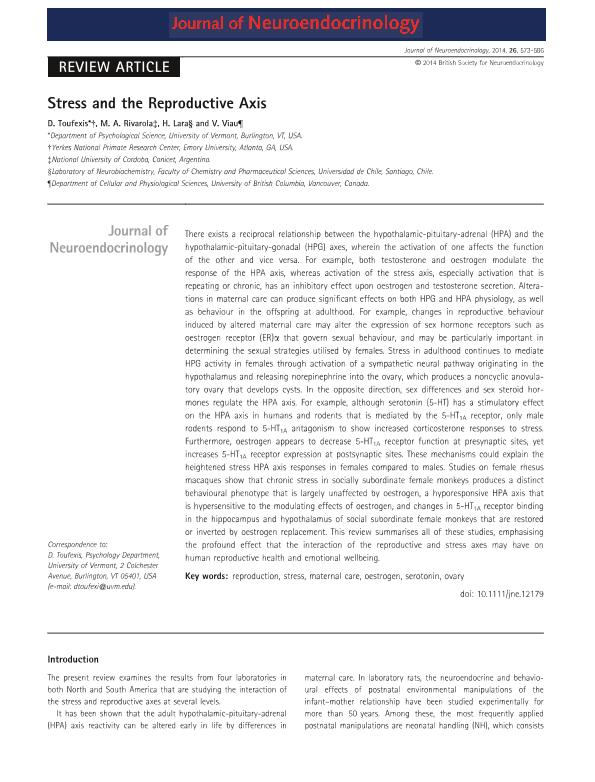Mostrar el registro sencillo del ítem
dc.contributor.author
Toufexis, Donna
dc.contributor.author
Rivarola, María Angélica

dc.contributor.author
Lara, Hernan
dc.contributor.author
Viau, Victor
dc.date.available
2018-01-22T16:21:38Z
dc.date.issued
2014-06
dc.identifier.citation
Toufexis, Donna; Rivarola, María Angélica; Lara, Hernan; Viau, Victor; Stress and the Reproductive Axis; Wiley Blackwell Publishing, Inc; Journal of Neuroendocrinology; 26; 9; 6-2014; 573-583
dc.identifier.issn
0953-8194
dc.identifier.uri
http://hdl.handle.net/11336/34091
dc.description.abstract
There exists a reciprocal relationship between the hypothalamic-pituitary-adrenal (HPA) and the hypothalamic-pituitary-gonadal (HPG) axes, wherein the activation of one affects the function of the other and vice versa. For example, both testosterone and oestrogen modulate the response of the HPA axis, whereas activation of the stress axis, especially activation that is repeating or chronic, has an inhibitory effect upon oestrogen and testosterone secretion. Alterations in maternal care can produce significant effects on both HPG and HPA physiology, as well as behaviour in the offspring at adulthood. For example, changes in reproductive behaviour induced by altered maternal care may alter the expression of sex hormone receptors such as oestrogen receptor (ER)α that govern sexual behaviour, and may be particularly important in determining the sexual strategies utilised by females. Stress in adulthood continues to mediate HPG activity in females through activation of a sympathetic neural pathway originating in the hypothalamus and releasing norepinephrine into the ovary, which produces a noncyclic anovulatory ovary that develops cysts. In the opposite direction, sex differences and sex steroid hormones regulate the HPA axis. For example, although serotonin (5-HT) has a stimulatory effect on the HPA axis in humans and rodents that is mediated by the 5-HT1A receptor, only male rodents respond to 5-HT1A antagonism to show increased corticosterone responses to stress. Furthermore, oestrogen appears to decrease 5-HT1A receptor function at presynaptic sites, yet increases 5-HT1A receptor expression at postsynaptic sites. These mechanisms could explain the heightened stress HPA axis responses in females compared to males. Studies on female rhesus macaques show that chronic stress in socially subordinate female monkeys produces a distinct behavioural phenotype that is largely unaffected by oestrogen, a hyporesponsive HPA axis that is hypersensitive to the modulating effects of oestrogen, and changes in 5-HT1A receptor binding in the hippocampus and hypothalamus of social subordinate female monkeys that are restored or inverted by oestrogen replacement. This review summarises all of these studies, emphasising the profound effect that the interaction of the reproductive and stress axes may have on human reproductive health and emotional wellbeing.
dc.format
application/pdf
dc.language.iso
eng
dc.publisher
Wiley Blackwell Publishing, Inc

dc.rights
info:eu-repo/semantics/openAccess
dc.rights.uri
https://creativecommons.org/licenses/by-nc-sa/2.5/ar/
dc.subject
Reproduction
dc.subject
Stress
dc.subject
Maternal Care
dc.subject
Estrogen
dc.subject
Serotonin
dc.subject
Ovary
dc.subject.classification
Salud Ocupacional

dc.subject.classification
Ciencias de la Salud

dc.subject.classification
CIENCIAS MÉDICAS Y DE LA SALUD

dc.title
Stress and the Reproductive Axis
dc.type
info:eu-repo/semantics/article
dc.type
info:ar-repo/semantics/artículo
dc.type
info:eu-repo/semantics/publishedVersion
dc.date.updated
2018-01-22T14:20:29Z
dc.journal.volume
26
dc.journal.number
9
dc.journal.pagination
573-583
dc.journal.pais
Reino Unido

dc.journal.ciudad
Londres
dc.description.fil
Fil: Toufexis, Donna. University of Vermont; Estados Unidos. University of Emory; Estados Unidos
dc.description.fil
Fil: Rivarola, María Angélica. Consejo Nacional de Investigaciones Científicas y Técnicas; Argentina. Universidad Nacional de Córdoba; Argentina
dc.description.fil
Fil: Lara, Hernan. Universidad de Chile; Chile
dc.description.fil
Fil: Viau, Victor. University of British Columbia; Canadá
dc.journal.title
Journal of Neuroendocrinology

dc.relation.alternativeid
info:eu-repo/semantics/altIdentifier/doi/http://dx.doi.org/10.1111/jne.12179
dc.relation.alternativeid
info:eu-repo/semantics/altIdentifier/url/http://onlinelibrary.wiley.com/doi/10.1111/jne.12179/abstract
dc.relation.alternativeid
info:eu-repo/semantics/altIdentifier/url/https://www.ncbi.nlm.nih.gov/pmc/articles/PMC4166402/
Archivos asociados
